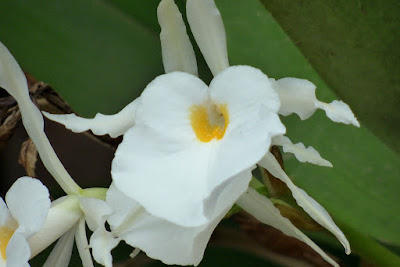Trichopilia fragrans is native to Colombia, Ecuador, Peru, Bolivia and Venezuela. In Ecuador they occurs in many places at an altitude of 1150-2400 m above sea level...
Trichopilia fragrans also called as The Fragrant Trichopilia, Pilumna fragrans, Pilumna nobilis, Trichopilia albida, Trichopilia candida, Trichopilia fragrans var. nobilis, Trichopilia lehmannii, Trichopilia nobilis, is a species of the genus Trichopilia. This species was described by Heinrich Gustav Reichenbach in 1858.
IDENTIFY TRICHOPILLIA FRAGRANS
Trichopilia fragrans is native to Colombia, Ecuador, Peru, Bolivia and Venezuela. In Ecuador they occurs in many places at an altitude of 1150-2400 m above sea level, most often at an altitude of about 2000 m. In Peru it grows damp mountain forests on trees or on the forest floor. The height of the habitat of this species in Peru ranges from 1500 to 2400 m. In Venezuela this species occurs in the state of Bolivar at an altitude of about 1070 m, near Caracas and in the state of Merida at an altitude of 1500 m. In Colombia, this orchid grows at an altitude of 1800-2500 m.
It is a small sized, cool to cold growing epiphyte or terrestrial in leaf mold on the forest floor with clustered, almost ligulate, slightly compressed, 10-12 cm long and 3 cm wide pseudobulbs carrying a single apical, oblong-ligulate, subacute, coriaceous, erect or suberect, 16.5 cm long and 3.8 cm wide leaf.
The Fragrant Trichopilia blooms in the winter on a basal, pendulous, 12" (30 cm) long, 2 to 5 flowered inflorescence with pale green, spotted dark brown bracts and large, fragrant, waxy, long-lasting flowers. The flowers have different dimensions, but they can reach up to 11.4 cm in diameter. The petals and sepals are greenish-white, narrow, oblong-lanceolate, with sharp tips and wavy margins. A large lip is snow-white with a golden-yellow spot in the neck. At the base the lip has a wedge shape, its lateral lobes are wrapped around the column, and the middle lobe is wide, with a shallow notch in the middle of the tip.
TRICHOPILLIA FRAGRANS CARE AND CULTURE
Cultural information should only be used as a guide, and should be to be adapted to suit you. Your physical location; where you grow your plants, how much time you have to devote to their care, and many other factors, will need to be taken into account. Only then can you decide on the cultural methods that best suit you and your plants.
Light:
Trichopilia fragrans needs a light level of 18000-20000 lux.
Temperature:
The average temperature of the summer day is 24-26 ° C, night 15 ° C, and the daily difference is 9-11 ° C. The average temperature of the winter day is 23-24 ° C, the night 13-14 ° C, and the daily difference is 10 ° C.
Humidity:
The Fragrant Trichopilia needs the humidity of almost 80% throughout the year.
Substrate, growing media and repotting:
Trichopilia fragrans are best grown in pots filled with any loose, quickly drying substrate.
Watering:
The plants should often be watered from spring to autumn, but the roots must dry quickly after watering. When new growths reach maturity, the amount of water should be reduced.
Fertilizer:
Weekly application of 1/4-1/2 of the recommended dose of orchid fertilizer during active growth is recommended. You can use sustainable fertilizer throughout the year, but also can use high-nitrogen fertilizer from spring to mid-summer, and then until the end of autumn, high phosphorus fertilizer.
Rest period:
The amount of water for Trichopilia fragrans in winter should be reduced to less than a few days, and they can not stay without water for too long. Fertilization should be reduced or eliminated until spring, when watering increases.















COMMENTS